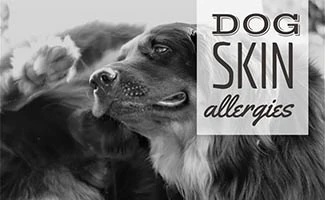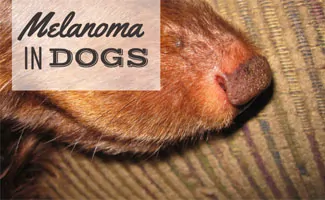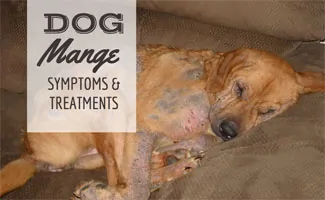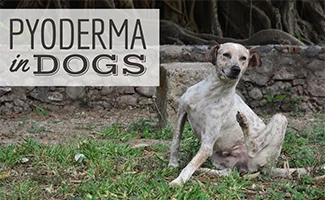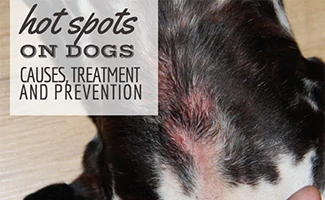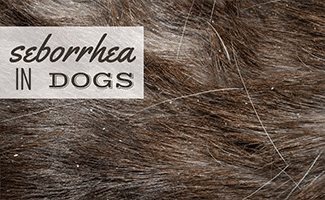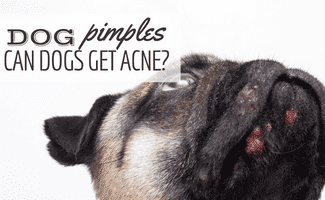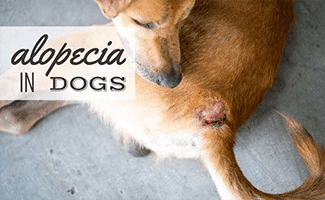
To keep the lights on, we receive affiliate commissions via some of our links. Our review process.
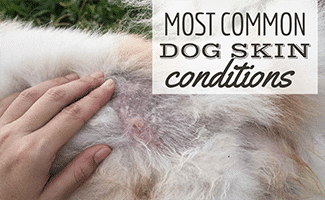
Skin conditions are among the top three health concerns in dogs, according to the American Veterinary Medical Association (AVMA) and other experts. Unfortunately, dogs are prone to many different skin conditions, and as pet parents, it can be challenging to pinpoint the exact problem. Many dog skin conditions appear as itchy, red skin, and others are scabby bumps with hair loss.
We’ll help give you an overview of the most common dog skin conditions, including the causes, symptoms to look out for, and typical treatment protocols. If you think your dog could be suffering from a specific disease, be sure to click on our links for more information about each condition.
Signs Of Skin Problems In Dogs
Contents
The symptoms of dog skin conditions can be the same for a wide variety of problems. But here are some of the most common signs.
- Red, inflamed skin
- Bumps on dog’s skin
- Rashes
- Scabs
- Hair loss
- Excessive scratching
- Excessive licking
10 Most Common Dog Skin Conditions
Since different dog skin problems can have many similar symptoms, we encourage you to read below to help you distinguish what your dog may be suffering from. However, because symptoms can be so similar, you should get your pup checked out by your veterinarian to get an accurate diagnosis and treatment plan.
1. Skin Allergies
Many dogs suffer from skin allergies, also known as allergic dermatitis or atopic dermatitis. The most common causes are food, flea bites, and environmental factors, e.g., pollen, grasses, and dust. Signs of dog skin allergies include frequent itching, red and inflamed skin, rashes, hives, bumps on the skin, and hair loss.
To treat skin allergies in dogs, you and your veterinarian must first determine the cause. Fleas are easy to diagnose and treat. But figuring out which food ingredients or environmental allergens are causing your pup’s itchy, irritated skin can get tricky and often requires a lengthy process of elimination.
You may want to start with an at-home dog allergy test kit, which may help identify common allergens and food ingredients that are causing an insensitivity in your pup. Then you can take the results to your vet to help with a treatment plan. For food allergies, a change in diet will usually do the trick. Environmental or seasonal allergies can be managed with medications recommended by your vet.
2. Skin Cancer
If you’ve found a growth or lump on your dog’s skin, it’s important to get your pup veterinary attention as soon as possible. Skin growths and lumps are very common in dogs, especially as they age, but not all are cancerous. Because it’s difficult to spot what type of growth your dog has, your vet will need to make a proper diagnosis. When caught early, many dog skin cancers are fully treatable. Three of the most common skin cancers in dogs are malignant melanoma, mast cell tumors, and squamous cell carcinoma.
- Malignant melanoma most often occurs on the lips or mouth, in the nail bed, or on the pads and can appear as a dark or pink spot.
- Mast cell tumors most commonly grow on the limbs, chest, and lower abdomen and are often red and itchy.
- Squamous cell carcinoma often grows in lighter-pigmented areas of the body, e.g., on the abdomen or around the genitals, but can be found in other locations. These tumors can vary in their appearance but most often appear as crusty raised bumps that resemble warts.
What causes skin cancer in dogs? Research has shown that genetics is a major factor, with some breeds being predisposed. Other causes may include too much sun exposure (especially on light-skinned dogs), some viruses, and hormonal abnormalities. Surgical removal is usually required with dog skin cancers. And if cancer has spread, pups could also need radiation therapy and sometimes chemotherapy.
3. Mange
Although often thought of as a condition only affecting neglected animals, mange actually is a pretty common dog skin condition caused by parasitic mange mites. There are two types of mange: demodectic and sarcoptic, each caused by a different mite species but with similar symptoms. Early signs include severe itchiness, redness, and rashes.
Sarcoptic mange is contagious and often first occurs on dogs’ ears. Dogs with weakened immune systems are especially susceptible to demodectic mange. If left untreated, this crusty dog skin condition causes painful thick scabs on dogs, widespread hair loss, and even emaciation. So it’s important to seek veterinary care as soon as you suspect a problem. Treatment typically involves medication and medicated shampoo prescribed by your vet.
4. Ringworm
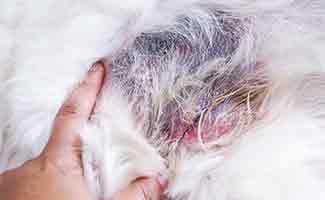
Ringworm has a misleading name — it’s not a worm but an infection caused by a few different fungi. Also called dermatophytes, this common fungal infection isn’t a serious health threat, but it’s highly contagious to dogs, cats, and people. So prompt vet care is essential to keep it from spreading to others.
Ringworm signs include roughly circular areas of hair loss and red, inflamed, or scabby skin that’s not usually itchy. Untreated lesions become more oversized and irregular in shape, and the fungus can spread to other areas of the body. In most cases, treatment involves oral medication along with a medicated topical ointment. Thorough environmental cleaning is also crucial because contact with the fungal spores on contaminated surfaces can also cause infection.
It’s important to note that yeast, a different kind of fungi that’s normally found on a dog’s body, can cause skin yeast infections in dogs when there’s fungal overgrowth. Yeast infections are usually caused by allergies or a suppressed immune system. Yeast infections can cause itchy, irritated, red skin or ears, often with a musty odor, and scabs on dogs. Unlike ringworm, skin yeast infections in dogs aren’t contagious.
5. Pyoderma
Pyoderma is a bacterial skin infection that typically appears as small, raised, red pus-filled bumps that resemble human pimples. Additional signs include dry, flaky patches, skin redness, itchiness, and sometimes hair loss. Pyoderma is often called impetigo in puppies.
Pyoderma can result from open wounds, broken skin, excessive moisture, excessive scratching, changes to normal skin bacteria, and other factors that cause the skin to be susceptible to bacteria growth. It’s often a secondary infection to allergic dermatitis (from fleas, food, or environmental factors).
Dogs with underlying conditions that suppress the immune system, e.g., Cushing’s disease, hypothyroidism, use of steroid medication, etc., can be more prone to developing pyoderma. Pyoderma treatment can include antibiotics and topical cream or sprays. Your vet will also diagnose and treat any underlying health problems causing your pup’s bacterial infection.
6. Hot Spots
If your dog has an area of skin that she’s scratching or licking that looks red, raw, inflamed, and oozy, it’s likely a hot spot. A hot spot, also known as acute moist dermatitis, is a painful and itchy skin condition that’s usually caused by self-trauma (excessive licking and chewing). Hot spots can be triggered by anything that makes your dog itchy, e.g., flea bites, skin allergies, ear infections, etc., and even by stress or boredom. And they can occur anywhere on the body.
These lesions can get very large and more irritated by constant self-trauma and often develop a bacterial infection very quickly, so it’s important to get your pup vet care as soon as possible. Treatment for hot spots typically includes a vet-prescribed oral or topical steroid to control itching and inflammation, antibiotics if it’s infected with bacteria, and the use of an Elizabethan collar to prevent further self-trauma. The underlying cause also requires treatment.
7. Folliculitis
Folliculitis is the inflammation of hair follicles that leads to redness, swelling, itchiness, and pain. It’s often caused by the overgrowth of bacteria triggered by another skin condition, such as skin allergies, mange, or fleas. Hormone disorders or self-trauma can also cause folliculitis.
This common condition in dogs first appears as a small, red, raised bump on the skin around a hair follicle that looks like a pimple. The bump can become pus-filled and eventually burst, leading to a flaky, crusty lesion. Over time, the lesion can become thick, darker, or hyperpigmented. Folliculitis requires veterinary treatment, including oral antibiotics and topical therapy such as ointment, spray, or shampoo.
8. Seborrhea
If your dog’s skin is greasy and smelly or flaky and itchy, seborrhea could be the culprit. Seborrhea is a skin disease that causes the sebaceous glands to either produce too much oil on the skin (seborrhea oleosa) or not enough, leading to dry, flaky, and irritated skin (seborrhea sicca). In most dogs, the two types occur simultaneously, so symptoms are a mix of oily, dry (dandruff), itchy, and red skin and also hair loss in some cases.
Seborrhea can be inherited or a secondary condition caused by an underlying health problem, such as allergies, parasites, hormonal imbalances, or fungal infections. It’s commonly treated and managed with medicated antiseborrheic shampoos and moisturizers for dry areas. In secondary seborrhea, it’s also important for your vet to treat the underlying cause.
9. Pimples & Acne
Yes, dogs can get acne and pimples just like humans, but it’s a bit different in dogs. Canine acne is a skin disorder that affects the lips, the skin around the mouth, and the chin. In dogs, it’s caused by folliculitis (see above) or furunculosis — when the inflamed hair follicles become infected, pus-filled, and painful.
Mild cases look like small red bumps or pustules (pimples). More severe cases can also cause the lips and muzzle to swell. Over time, the bumps grow larger, drain fluid, and can become infected. The underlying cause of dog acne is relatively unknown, but it’s suspected that allergies, skin trauma, age, and a genetic predisposition contribute to its development.
Dog pimples and acne symptoms can resemble other skin problems, so it’s important to get a proper diagnosis from your vet. Mild cases can usually be treated with vet-recommended benzoyl peroxide, while more severe cases may require oral or topical steroids and topical antibiotics.
10. Alopecia
Alopecia in dogs is a broad term used to describe hair loss, either due to hair falling out or hair failing to grow. It’s very common in dogs, and there are numerous underlying causes — parasites, skin infections, hormonal disorders, pattern baldness, and more. If your dog has bare patches of fur, you should see your vet to determine what’s causing the hair loss and get the appropriate treatment.
How Can I Help Keep My Dog’s Skin Healthy?
Although you can’t always prevent skin conditions in dogs, there are several things you can do to help keep your pup’s skin and coat as healthy as possible to ward off some skin conditions. Note: Be sure to consult your vet before giving your dog any supplements. These include:
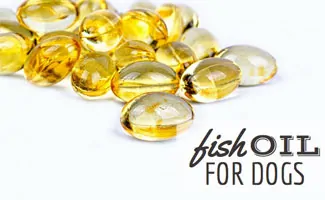
- Your dog’s diet can make a big difference ‐ feeding your pup a healthy diet that’s full of all-natural ingredients that support immune health and skin and coat health can help a lot.
- Fish oil supplements contain omega-3 fatty acids that can help support healthy skin and coat and reduce inflammation.
- Dietary supplements, such as vitamins A, C, and E, may help with general immunity protection and skin conditions.
- Regular use of an oatmeal-based shampoo may help keep your dog’s skin hydrated and healthy and can also relieve itchiness and irritated skin.
- Brushing your dog’s coat regularly (at least every two days) can help stimulate the skin’s oil glands, keep hair follicles healthy, and remove dead skin cells.
Handling The Costs Of Dog Health Problems
Skin conditions are among the most common reasons that pet owners seek out veterinarian care. Some skin conditions, like skin cancer, can be extremely expensive to treat. And other chronic conditions, like allergies, can also rack up the vet bills for ongoing diagnostics and treatment.
If you’re worried about how you’ll be able to pay your vet bills with these and other unexpected illnesses and accidents, you may want to consider pet insurance. If you invest in pet insurance before problems arise, many policies cover a portion of these costly vet bills (as long as it’s not a pre-existing condition). Learn more about pet insurance and whether it’s worth it for you and your pup.
Tagged With: Skin
